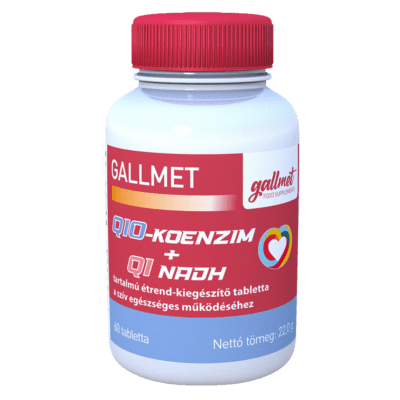About homocysteine - a little biochemistry and history

Homocysteine is an amino acid that is essential for maintaining normal cellular function, but high homocysteine levels have undesirable effects. There are two ways to get rid of excess homocysteine:
- It is converted into methionine by the body in the presence of vitamin B12 and folate, using two enzymes (MS and MTHFR).
- It is converted by an enzyme in the liver (BHMT) - with betaine and vitamin B6 - and then excreted in the urine.1
The clinical importance of homocysteine became apparent in 1962, when it was first discovered that patients with high homocysteine levels were at a particularly high risk of vascular occlusion.
Short conversation with subtitles in several languages:
Our advisory phone number: 06-79-326-581
GALLMET Heart Plus capsules contain folate (vitamin B9), betaine, vitamins B6 and B12, which contribute to the body's proper homocysteine levels!💊
Harmful effects of high homocysteine levels2
- Damages the inner surface of blood vessels (endothelial function).
- It increases the adhesion of platelets to each other and thus the risk of blood vessel blockage.
- Increases blood clotting.
- Damages the ability of blood vessels to dilate.
- It inhibits the antioxidant activity of glutathione peroxidase, which plays a crucial role in neutralising harmful oxygen radicals.
What can cause my homocysteine level to be high?
- inherited genetic disorders
- dietary habits: higher animal protein, fat and sugar intake
- the active ingredients of the medicines you are taking:
- medicines for diabetes (insulin, metformin, cholestyramine),
- medicines containing female hormones (oestrogen),
- breast cancer drugs (tamoxifen),
- medicines used for epilepsy (carbamazepine, phenytoin, phenobarbital),
- medicines for rheumatism and psoriasis (methotrexate),
- diuretics (thiazide),
- medicines used for Crohn's disease and ulcerative colitis (sulphasalazine),
- etc. 4, 5
- low folate intake
- ageing
- smoking
- oxidative stress
What is the normal homocysteine level?
Our advisory phone number: 06-79-326-581
Short conversation with subtitles in several languages
- In healthy humans, the optimal homocysteine level in blood is between 5.0 and 15.0 μmol/l (measured by high-performance liquid chromatography - HPLC) or 5.0-12.0 μmol/l (determined by ELISA).
- More recently, even lower levels (7.2 μmol/l ELISA)13 have been found, above which homocysteine levels are a risk factor.6 In this case, it is already worth consuming a product containing the vitamins and betaine needed to reduce homocysteine levels!
How do I know for sure if my homocysteine level is high?
- Laboratory tests: Synlab
What are the chances that I have inherited faulty genes?

One study found that gene defect inherited from only one parent (heterozygous C/T) were present in 45.2% of cases, while gene defects inherited from both parents (homozygous T/T) were present in 11.1%.7
So more than half of the population has this gene defect. This gene defect, which occurs at base 677 of the MTHFR gene, impairs the function of the enzyme that regulates homocysteine levels.
If the gene defect is present in the form inherited from both parents (homozygous T/T), the homocysteine-lowering enzyme is 50-60% less effective.
In the case of a gene defect inherited from only one parent (heterozygous C/T), there is a 25-30% decrease in homocysteine-lowering enzyme function.
How do I know if I have a genetic problem and if I have high homocysteine levels?
- Alzheimer's disease,
- Parkinson's disease,
- dementia,
- thrombosis,
- cerebrovascular diseases,
- cardiovascular diseases,
- cancer,
- severe or fatal SARS-Cov2 infection.
How do I know for sure that I have inherited the MTHFR C677T gene defect?
- Laboratory tests: Synlab
What should I eat to get enough vitamins betaine, B6, B9 and B12?

| Wheat bran | 1339 mg / 100 g |
| Wheat germ | 1241 mg / 100 g |
| Spinach | 622 mg / 100 g |
| Beetroot | 200 mg / 100 g |
| Wheat bread | 200 mg / 100 g |
| Biscuits | 125 mg / 100 g |
The table shows that the amount of betaine needed to favourably influence homocysteine cannot be consumed with a normal meal, so supplementation may be recommended for those affected.
The folate intake of the European population is also very low (spinach and pulses contain the highest amounts), only about a third of the dietary recommendations.11
It should be noted that many products containing vitamin B9 contain folic acid, while the bioavailability of folic acid is not the same as natural folate in patients with common gene defects - MTHFR 1298C and C677T. Folic acid does not directly reduce homocysteine levels but can cause kidney damage and, unlike natural folate, does not cross the blood-brain barrier!12
GALLMET Heart Plus capsules contain folate (vitamin B9), betaine, vitamins B6 and B12, which contribute to the body's proper homocysteine levels!💊
TRY GALLMET HEART PLUS CAPSULES NOW AT A SPECIAL INTRODUCTORY PRICE!
Click on the [print-me] icon to print the page
[1] Assessment of plasma homocysteine levels in ischaemic heart patients - Dr. László Márk, Dr. Ferenc Erdei, Dr. János Márki-Zay, Dr. Erika Nagy, Dr. András Kondacs and Dr. András Katona - Orvosi hetilap_2001.07.29. http://real-j.mtak.hu/11264/
[2] Assessment of plasma homocysteine levels in ischaemic heart patients - Dr. László Márk, Dr. Ferenc Erdei, Dr. János Márki-Zay, Dr. Erika Nagy, Dr. András Kondacs and Dr. András Katona - Orvosi hetilap_2001.07.29. http://real-j.mtak.hu/11264/
[3] Homocysteine - from disease biomarker to disease prevention - Smith AD, Refsum H. https://onlinelibrary.wiley.com/doi/10.1111/joim.13279
[4] Using data mining technology to explore homocysteine at low levels - Tseng FC, Huang TC. https://www.ncbi.nlm.nih.gov/pmc/articles/PMC8376364/
[5] The role of homocysteine in the pathogenesis of early-onset ischaemic heart disease - Dr. Lajos Szollár http://real.mtak.hu/62/1/34815_ZJ1.pdf
[6] Homocysteine - from disease biomarker to disease prevention - Smith AD, Refsum H. https://onlinelibrary.wiley.com/doi/10.1111/joim.13279
[7] Physiological and pathophysiological significance of vitamin B9 - Sára Zsigrai, Alexandra Kalmár, Gábor Valcz, Krisztina Andrea Szigeti, Barbara Kinga Barták, Zsófia Brigitta Nagy, Péter Igaz, Zsolt Tulassay and Béla Molnár https://akjournals.com/view/journals/650/160/28/article-p1087.xml
[8] Homocysteine metabolism as the target for predictive medical approach, disease prevention, prognosis, and treatments tailored to the person - Koklesova L, Mazurakova A, Samec M, Biringer K, Samuel SM, Büsselberg D, Kubatka P, Golubnitschaja O. https://www.ncbi.nlm.nih.gov/pmc/articles/PMC8581606/
[9] Homocysteine metabolism as the target for predictive medical approach, disease prevention, prognosis, and treatments tailored to the person - Koklesova L, Mazurakova A, Samec M, Biringer K, Samuel SM, Büsselberg D, Kubatka P, Golubnitschaja O. https://www.ncbi.nlm.nih.gov/pmc/articles/PMC8581606/
[10] Homocysteine and the SARS-CoV-2 Coronavirus - the X Factor of Severe Disease and Death - Nancy Lord & Mary Ruwart https://papers.ssrn.com/sol3/papers.cfm?abstract_id=3708654
[11] The role of homocysteine in the pathogenesis of early-onset ischaemic heart disease - Dr. Lajos Szollár http://real.mtak.hu/62/1/34815_ZJ1.pdf
[12] New Evidence for Homocysteine Lowering for Management of Treatment-Resistant Hypertension - Merrill F. Elias and Craig J. Brown https://academic.oup.com/ajh/article/35/4/303/6475983
[13] Homocysteine: Highs, Lows, and Optimals - Dicken Weatherby, N.D. and Beth Ellen DiLuglio, MS, RDN, LDN https://www.optimaldx.com/blog/homocysteine-optimal-range







